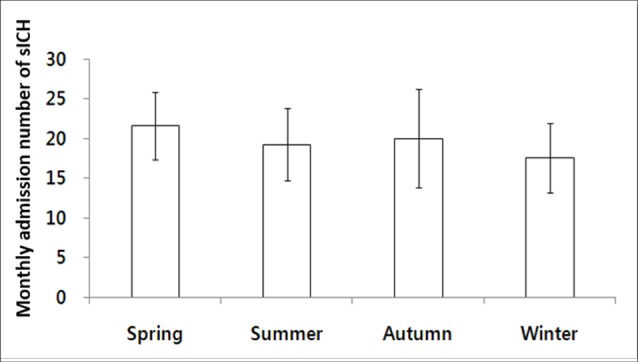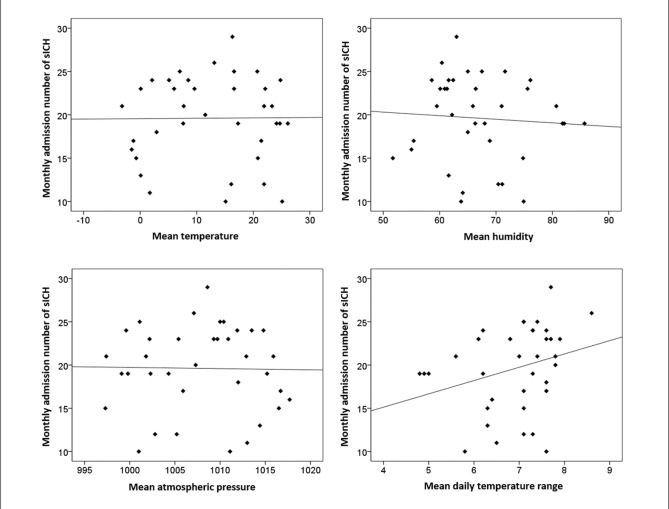J Cerebrovasc Endovasc Neurosurg.
2013 Sep;15(3):152-157. 10.7461/jcen.2013.15.3.152.
Association Between the Daily Temperature Range and Occurrence of Spontaneous Intracerebral Hemorrhage
- Affiliations
-
- 1Department of Neurosurgery, Gil Medical Center, Gachon University, Incheon, Korea. cwpark@gilhospital.com
- KMID: 1491432
- DOI: http://doi.org/10.7461/jcen.2013.15.3.152
Abstract
OBJECTIVE
We have observed, anecdotally, that the incidence of primary spontaneous intracerebral hemorrhage (sICH), as well as spontaneous subarachnoid hemorrhage, varies in accordance with seasonality and meteorological conditions. This retrospective single-hospital-based study aimed to determine the seasonality of sICH and the associations, if any, between the occurrence of sICH and meteorological parameters in Incheon city, which is a northwestern area of South Korea.
METHODS
Electronic hospital data on 708 consecutive patients admitted with primary sICH from January 2008 to December 2010 was reviewed. Traumatic and various secondary forms of ICHs were excluded. Average monthly admission numbers of sICH were analyzed, in relation with the local temperature, atmospheric pressure, humidity, and daily temperature range data. The relationships between the daily values of each parameter and daily admission numbers of sICH were investigated using a combination of correlation and time-series analyses.
RESULTS
No seasonal trend was observed in sICH-related admissions during the study period. Furthermore, no statistically significant correlation was detected between the daily sICH admission numbers and the meteorological parameters of temperature, atmospheric pressure and humidity. The daily temperature range tended to correlate with the number of daily sICH-related admissions (p = 0.097).
CONCLUSION
This study represents a comprehensive investigation of the association between various meteorological parameters and occurrence of spontaneous ICH. The results suggest that the daily temperature range may influence the risk of sICH.
MeSH Terms
Figure
Reference
-
1. Ali Y, Rahme R, Matar N, Ibrahim I, Menassa-Moussa L, Maarrawi J, et al. Impact of the lunar cycle on the incidence of intracranial aneurysm rupture: Myth or reality? Clin Neurol Neurosurg. 2008; 5. 110(5):462–465. PMID: 18353534.
Article2. Anderson CS, Chakera TM, Stewart-Wynne EG, Jamrozik KD. Spectrum of primary intracerebral haemorrhage in Perth, Western Australia, 1989-90: Incidence and outcome. J Neurol Neurosurg Psychiatry. 1994; 8. 57(8):936–940. PMID: 8057117.
Article3. Broderick JP, Brott T, Tomsick T, Miller R, Huster G. Intracerebral hemorrhage is more than twice as common as subarachnoid hemorrhage. J Neurosurg. 1993; 2. 78(2):188–191. PMID: 8421201.4. Capon A, Demeurisse G, Zheng L. Seasonal variation of cerebral hemorrhage in 236 consecutive cases in Brussels. Stroke. 1992; 1. 23(1):24–27. PMID: 1731416.
Article5. Chambers JB, Williams TD, Nakamura A, Henderson RP, Overton JM, Rashotte ME. Cardiovascular and metabolic responses of hypertensive and normotensive rats to one week of cold exposure. Am J Physiol Regul Integr Comp Physiol. 2000; 10. 279(4):R1486–R1494. PMID: 11004019.
Article6. Cowperthwaite MC, Burnett MG. The association between weather and spontaneous subarachnoid hemorrhage: An analysis of 155 US hospitals. Neurosurgery. 2011; 1. 68(1):132–138. discussion 138-9. PMID: 21099710.
Article7. Feldmann E, Broderick JP, Kernan WN, Viscoli CM, Brass LM, Brott T, et al. Major risk factors for intracerebral hemorrhage in the young are modifiable. Stroke. 2005; 9. 36(9):1881–1885. PMID: 16081867.
Article8. Giaconi S, Ghione S, Palombo C, Genovesi-Ebert A, Marabotti C, Fommei E, et al. Seasonal influences on blood pressure in high normal to mild hypertensive range. Hypertension. 1989; 7. 14(1):22–27. PMID: 2737734.
Article9. Gill RS, Hambridge HL, Schneider EB, Hanff T, Tamargo RJ, Nyquist P. Falling temperature and colder weather are associated with an increased risk of aneurysmal subarachnoid hemorrhage. World Neurosurg. 2013; 1. 79(1):136–142. PMID: 22732514.
Article10. Haberman S, Capildeo R, Rose FC. The seasonal variation in mortality from cerebrovascualr disease. J Neurol Sci. 1981; 10. 52(1):25–36. PMID: 7299414.11. Hughes MA, Grover PJ, Butler CR, Elwell VA, Mendoza ND. A 5-year retrospective study assessing the association between seasonal and meteorological change and incidence of aneurysmal subarachnoid haemorrhage. Br J Neurosurg. 2010; 8. 24(4):396–400. PMID: 20726749.
Article12. Inagawa T. Diurnal and seasonal variations in the onset of primary intracerebral hemorrhage in individuals living in Izumo City, Japan. J Neurosurg. 2003; 2. 98(2):326–336. PMID: 12593619.
Article13. Inagawa T, Takechi A, Yahara K, Saito J, Moritake K, Kobayashi S, et al. Primary intracerebral and aneurysmal subarachnoid hemorrhage in Izumo City, Japan. Part I: Incidence and seasonal and diurnal variations. J Neurosurg. 2000; 12. 93(6):958–966. PMID: 11117868.14. Jabbour P, Tjoumakaris S, Dumont A, Gonzalez LF, Rosenwasser R. Aneurysm rupture: Lunar cycle, weather, atmospheric pressure, myth or reality? World Neurosurg. 2011; Jul-Aug. 76(1-2):7–8. PMID: 21839928.
Article15. Keatinge WR, Coleshaw SR, Cotter F, Mattock M, Murphy M, Chelliah R. Increases in platelet and red cell counts, blood viscosity, and arterial pressure during mild surface cooling: Factors in mortality from coronary and cerebral thrombosis in winter. Br Med J (Clin Res Ed). 1984; 11. 289(6456):1405–1408.
Article16. Kleinpeter G, Schatzer R, Bock F. Is blood pressure really a trigger for the circadian rhythm of subarachnoid hemorrhage? Stroke. 1995; 10. 26(10):1805–1810. PMID: 7570729.17. Macdonald RL. Whether subarachnoid hemorrhage depends on the weather? World Neurosurg. 2013; 1. 79(1):64–65. PMID: 23103265.
Article18. Minami J, Kawano Y, Ishimitsu T, Yoshimi H, Takishita S. Seasonal variations in office, home and 24 h ambulatory blood pressure in patients with essential hypertension. J Hypertens. 1996; 12. 14(12):1421–1425. PMID: 8986924.
Article19. Shin MH, Park HK, Joo WI, Lee KJ, Rha HK. [Diurnal and Seasonal Variations in the Onset of Spontaneous Intracerebral Hemorrhage]. Korean J Cerebrovasc Surg. 2007; 3. 9(1):46–51. Korean.20. Rønning P, Langmoen IA. Aneurysm rupture-does the weather matter? World Neurosurg. 2013; 1. 79(1):62–63. PMID: 22858847.
Article21. Special report from the National Institute of Neurological Disorders and Stroke. Classification of cerebrovascular diseases III. Stroke. 1990; 4. 21(4):637–676. PMID: 2326846.22. Sobel E, Zhang ZX, Alter M, Lai SM, Davanipour Z, Friday G, et al. Stroke in the Lehigh valley: Seasonal variation in incidence rates. Stroke. 1987; Jan-Feb. 18(1):38–42. PMID: 3810768.
Article23. Takebayashi S. Ultrastructural morphometry of hypertensive medial damage in lenticulostriate and other arteries. Stroke. 1985; May-Jun. 16(3):449–453. PMID: 4002259.
Article
- Full Text Links
- Actions
-
Cited
- CITED
-
- Close
- Share
- Similar articles
-
- Relationship between Spontaneous Cerebral Hemorrhage and Climatic Factor
- Age and Meteorological Factors in the Occurrence of Spontaneous Intracerebral Hemorrhage in a Metropolitan City
- Multiple Spontaneous Intracerebral Hematoma without Presenting Risk Factors
- Computed Tomographic Findings and Clinical Observation of Spontaneous Intracerebral Hemorrhage
- Clinical Analysis for Stereotatic Aspiration and Thrombolysis of Spontaneous Intracerebral Hemorrhage




